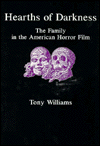|
Hearths of Darkness
by Tony Williams
|
 |
Chain Saw Massacres: The Apocalyptic Dimension
. . . The 1980s saw a drastic change in the form and character of
the American horror film. In 1980 a work appeared that heralded the genre's degeneration - Friday the 13th.
This film initiated another subgeneric movement variously entitled "slasher" or "stalker" film. Although most
commentators dismiss these films as worthless trash, they are symptomatic of their particular era and deserve
attention. The phenomenon did not emerge un heralded. As part of a corpus described as "Reaganite Entertainment,"
they belong to a cultural movement that gained momentum in the 1970s, erupting during the next decade. These
visually repugnant and thematically debased "slasher" films belong to an apocalyptic dimension influencing
contemporary horror. Works such as The Texas Chain Saw Massacre (1973), Race with the Devil (1975),
Eaten Alive (1977), The Brood (1979), The Funhouse, Scanners (both 1981), The
Texas Chain Saw Massacre 2 (1986), and Leatherface (1988) exemplify a particular apocalyptic
vision moving from disclosing family contradictions toward self-indulgent nihilism. . .(p. 183).
. . .Although Jason, Michael, and Freddy lack explicit supernatural attributes, their various resurrections
exemplify punitive biblical atavistic actions against youthful transgressors. "The horror film, even as it
steadily ignores the supernatural, becomes the best representation of the hold of Old Testament moralism in
popular culture, a hold enhanced by dominant ideology." Stability collapses. Family figures in the various
Friday the 13th, Halloween, and Nightmare on Elm Street films appear weak and ridiculous.
But nothing further results. As Sharrett notes, "The apocalyptic at work momentarily inoculates the
spectator with criticisms of a failing dominant order, but then reneges on this criticism by denying
that there is any worth in carrying this critical process through to a conclusion." Instead there is
only despair and a collective death wish involving cinematic sacrificial victims articulating fears
within the audience's psyche. . . (p. 184).
The Return of Kronos
. . .The reactionary nature of 1980s horror represents a culture
in crisis attempting to deny social breakdown. Teen characters escape either into random sexual experiences
or other avenues (drugs, comic books, rock music). Contemporary horror films attempt to inoculate the
radical potentialities of the Gothic by abandoning the monster's identification with the return of the
repressed. However, although these films try to remove the monster from its cultural context and identify
characters with dominant social norms, they are never totally successful. In contrast to a commonly held
belief, family horror films did not die in the 1980s. It took on a new form. Films such as Grave of
the Vampire and Black Christmas (both 1974) anticipated motifs within the Friday the 13th,
Halloween, Poltergeist, and Nightmare on Elm Street series. The monster is now the patriarchal
father. . . (p. 211).
. . .The brutal slaughter and high body count within various slasher films articulate deep-seated
fears of insecurity. In an era reacting against supposed permissiveness of earlier decades and lacking
viable radical alternatives, there is no exit for those hesitant to follow conformist patterns.
Childhood experience no longer remains sheltered from a violent world as kids within the Child's Play
series and Craven's The People under the Stairs (1991) discover. During a sequence played for laughs,
but having disturbing consequences beyond the "in-joke" context in Friday the 13th Part VI,
Jason Lives (1986), one sleeping eight-year-old has a copy of Sartre's No Exit on his bed.
Cynically bemused at Megan's survival tactics, he sees himself as little more than "dead meat" for
Jason. Before an expected sacrificial holocaust, his companion calmly responds, "So what were you
going to be when you grew up?". . . (p. 212).
. . .Despite reductive formulas and gratuitous special effects, the Friday
the 13th series contain family elements. The basic conservative formula appears in Sean Cunningham's
Friday the 13th (1980). A stalker who ritually slaughters promiscuous teenagers proves to be Mrs.
Voorhees (Betsy Palmer). She is avenging her deceased son, Jason. She is a phallic avenging mother,
speaking with his voice ("Kill her Mummy. Kill her"). Although Alice (Adrienne King) wins the battle,
she loses the war. A nightmare epilogue shows Jason emerging from Camp Crystal Lake to drag her beneath
the depths. In the prologue to Steve Miner's Friday the 13th, Part II (1981), Jason returns to
slaughter a no-longer resourceful, terrified Alice. Before Alice dies, she answers a phone call from
her dominating mother, an even hardly coincidental because Jason continues mother's disciplinary mission
in the film.
. . .Although Ginny (Amy Steel) recognizes Jason as a "child
trapped in a man's body. .. The only person he knew was his mother," she can only survive by
masquerading as his deceased phallic mother. Any intuitive feminist sympathy with the monster's
plight becomes lost. Jason's hut is a religious shrine with mother's decapitated head as a holy
object. Although Ginny survives, she is in a state of "severe hysterical shock." Friday the
13th, Part II ends with a track-in shot to the real winner, Mrs. Voorhees; Although dead her
decapitated head displays an active malignant influence.
. . .Miner's Friday the 13th, Part III (1982) continues Ginny's
insights into Jason's violence which possibly results from child abuse. It initially identifies him
with a future victim - inadequate, unloved teenager Shelley. Shelley plays scary practical jokes
and wears masks (one of which is Jason's hockey mask!). In an early scene he actually staggers
around with a fake axe in his head, anticipating Jason's demise. Although marginal in the film,
these scenes suggest Jason's violent acts represent repressed family rage which originates from
abuse and neglect. However patriarchal violence still wins. Mrs. Voorhees assaults survivor
Chris (Dawn Kimmel) in traumatic nightmares while Jason's executioner, young Tommy (Corey Feldman),
takes on his role in the climax of Joseph Zito's Friday the 13th: The Final Chapter (1984).

|